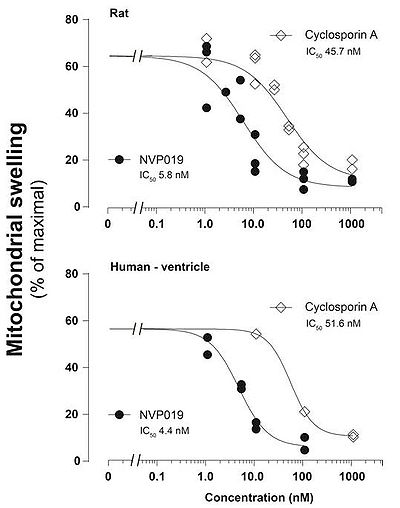Piel 2015 Abstract MiPschool London 2015
| The novel Cyclophilin D inhibitor NVP019 reduces mitochondrial permeability transition in isolated rat and human heart mitochondria. |
Link:
Piel S, Gregory M, Moss S, Hansson Magnus J (2015)
Event: MiPschool London 2015
Mitochondrial permeability transition pore (MPTP) opening is a critical event of ischemia-reperfusion (IR) injury following myocardial infarction [1]. At the time of reperfusion the mitochondria are confronted with an overload of calcium, phosphate and oxidative stress while still suffering from adenine nucleotide depletion. This triggers MPTP opening through the mitochondrial matrix protein Cyclophilin D (Cyp-D). Ciclosporin A (CsA) has long been known to inhibit MPTP opening through binding to Cyp-D and to protect the heart during IR injury. It has, however, off-target effects such as immunosuppression and multiple drug interactions [2]. The aim of this study was to assess the potential of NVP019, a novel, non-immunosuppressive Cyp-D inhibitor with minimal off-target effects [3], to inhibit mitochondrial permeability transition in heart tissue in vitro.
Mitochondrial swelling and calcium retention capacity was assessed in vitro on mitochondria isolated from rat heart tissue and human atrial and ventricular tissue in the presence and absence of NVP019 and CsA at different concentrations.
NVP019 inhibited swelling more potently than CsA in rat heart and human ventricular mitochondria with comparable effects in both species (IC50 5.8 nM vs 45.7 nM in rat heart and 4.4 nM vs 51.6 nM in human ventricular tissue). Further, the capacity to sequester calcium was increased in the presence of NVP019.
NVP019 is a potent inhibitor of MPTP opening in rat and human heart in vitro with a beneficial pharmacological profile and may thus be a promising drug candidate for treatment of IR injury during myocardial infarction.
• Keywords: Cyclophilin D
• O2k-Network Lab: SE Lund Elmer E
Labels: MiParea: Patients Pathology: Cardiovascular Stress:Ischemia-reperfusion Organism: Rat Tissue;cell: Heart Preparation: Isolated mitochondria
Affiliations
1-Mito Med, Dept Clinical Sc, Lund Univ, Sweden. - sarah.piel@med.lu.se
2-NeuroVive Pharmaceutical AB, Medicon Village, Lund
3-Isomerase Therapeutics, Cambridge, UK
Figures
References
- Hausenloy DJ, Duchen MR, Yellon DM (2003) Inhibiting mitochondrial permeability transition pore opening at reperfusion protects against ischemia-reperfusion injury. Cardiovasc Res 60:617-25.
- Halestrap AP, Richardson AP (2015) The mitochondrial permeability transition: a current perspective on its identity and role in ischaemia/reperfusion injury. J Mol Cell Cardiol 78:129-41.
- Hansson Magnus J, Moss SJ, Bobardt M, Chatterji U, Coates N, Garcia-Rivera JA, Elmer E, Kendrew S, Leyssen P, Neyts J, Nur EAM, Warneck T, Wilkinson B, Gallay P, Gregory MA (2015) Bioengineering and semisynthesis of an optimized cyclophilin inhibitor for treatment of chronic viral infection. Chem Biol 22:285-92.
